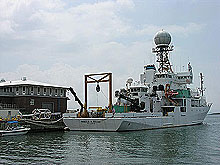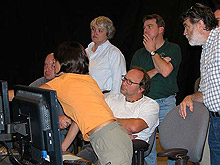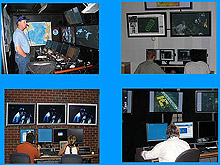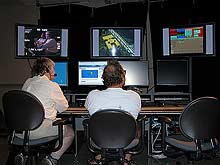
The Lost City expedition launched from Woods Hole, MA on July 17, 2005 heading for the Mid-Atlantic Ridge where it will explore the unique hydrothermal vent field called Lost City.
![]() Click
image to view a slide show.
Click
image to view a slide show.
The Expedition Begins
July 17, 2005
Deb Zeyen
NOAA's research ship Ronald H. Brown pulled away from the Woods Hole, MA dock. Dock crews and deckhands worked hard loading IFE ROV's Hercules and Argus, as well as all the scientific equipment and supplies necessary for the 19 day expedition to explore the Lost City hydrothermal vent field.
The ship will travel over 2,000 miles to the Mid-Atlantic Ridge (MAR). The expedition is headed towards the Atlantis Massif, which sits 15 km to the west of the MAR axial valley. We will explore the serpentinite-hosted Lost City hydrothermal field, that was discovered on a research expedition in 2000. This field forms an intriguing ecosystem where geological, chemical and biological processes are tied closely to the chemical reactions that formed the field. The microbial life found here depends on methane cycling, which differs greatly from microbes found around black smokers that have been studied in other locations.

Pamela Lezaeta, IFE contractor for technical operations, briefs scientists at the UW Science Control Center on how to use the console controls. Three flat screens carry images from the ROV control room and several locations on the ship's deck. When Hercules begins underwater exploration, live images will be transmitted instantly to these screens where scientists can study them. Pamela explains how the scientists can speak into the microphone directly to specific scientists or to the pilots of Argus and Hercules aboard the ship. Scientists can also select which data should be displayed from the four computer screens below the flat screens. Watch this site for a live feed starting July 23! Click image for larger view and image credit.
On the two earlier cruises to Lost City, funded by the National Science Foundation, scientists traveled on-board the ship, which is typical of traditional oceanographic research expeditions. This time we are trying a completely new system. On the ship we have loaded a satellite control room. The images we get from the bottom of the sea will be transmitted to the University of Rhode Island where the Inner Space Control Center forms the hub of the incoming satellite transmission and the export of images and data via internet. University of New Hampshire receives sonar data to assist with the development of maps. Another internet feed goes directly to University of Washington where a team of scientists is prepared to collect, record, and analyze the images as they arrive. In the future it will be possible for teams of scientists to participate in a cruise without stepping on the ship. This will mean that scientists save weeks of travel time and can have many more eyes and minds at work on the data.
So today we begin testing the four control rooms developed to receive and interpret this data. The control rooms each have large flat screen monitors to project the high definition images. Communications is routed through a switcher enabling a scientist at one location to speak directly to a selected person at another control room. In this way the scientists will be able to instruct the pilots of Hercules and the Argus to take specimens and acquire certain images. Today we are testing all four systems to prepare for our first dive on Saturday, July 23.

Four control rooms are being tested today. Upper left, Co-chief Scientist Bob Ballard tests communications on board NOAA ship Ronald H. Brown. Bob sees the same images and talks in real time to the Inner Space Center and University of Rhode Island (upper right); scientists and University of New Hampshire (lower left); and Co-chief Scientist Deborah Kelley at University of Washington. Click image for larger view and image credit.

Co-chief scientist Deborah Kelley and geologist Jeff Karson work at the Science Control Center at the University of Washington. The three flat screens carry images from the NOAA ship Ronald H. Brown. The scientists in this control room will see images from the ROV Hercules as it explores the chimneys of Lost City near the Mid-Atlantic Ridge. Images will be transmitted from the seafloor to the ship and then to the scientists at UW in less than 1 second. Data such as water temperature, depth, salinity, and precise location will be fed "live" to the control room. A group of over 20 scientists will be able to analyze the images and data as it arrives in real time.Click image for larger view and image credit.
Sign up for the Ocean Explorer E-mail Update List.


























